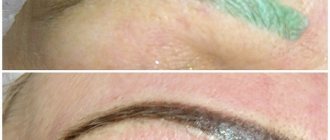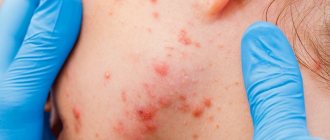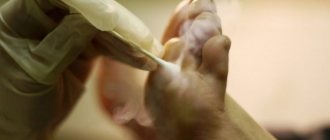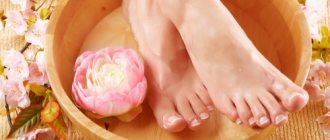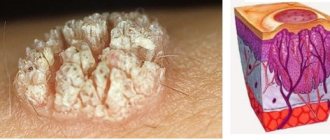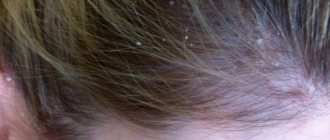Most often, a callus that appears on the heel can be eliminated at home. There are two types of such formations - dry and aqueous (wet), and each of these options requires its own approach to treatment. Pharmaceutical preparations and folk remedies help get rid of calluses. But it is recommended to consult with a specialist first, since different calluses have their own treatment options.
- Procedures for softening
Removing wet calluses
A wet callus is a blister filled with intercellular fluid. It is formed when the top layer of skin peels off, which happens with prolonged friction - due to uncomfortable shoes.
Such calluses occur in people with sensitive skin. And this is not just a cosmetic flaw. When you touch a blister, the top layer of skin can be punctured or damaged, there is a risk of a wound forming, and it often becomes painful to step on your foot.
If the wet callus with a blister has a small area, then simply seal it, but first apply any wound-healing ointment directly under the patch - a pea-sized amount is enough.
Piercing
If the callus is large, it is recommended to consult a doctor. It is highly undesirable to perform piercing at home. But if you want to get rid of the problem as quickly as possible, then piercing the callus at home should be treated as a minor surgical operation. All precautions must be taken to avoid infection.
Particular care must be taken with regard to those blisters that contain not transparent intercellular fluid, but ichor. This is a sign that the damage has reached deep enough layers and reached the blood vessels.
Proceed as follows:
- Prepare a needle from a sterile disposable syringe in advance. You can first place it in medical alcohol or hydrogen peroxide.
- Wash your hands with soap and disinfect them with an antiseptic composition containing chlorhexidine.
- A needle makes several punctures in the callus sac.
- A sterile napkin is placed on top of the blister and lightly pressed on it so that the liquid flows out and is absorbed into the material.
Afterwards, the skin area is treated with an antiseptic and lubricated with a cream that has wound-healing properties, otherwise a dry callus will quickly form.
Compresses
You can get rid of calluses using aloe:
- The leaf is applied to the callus.
- Leave it overnight.
Onion compress has similar softening properties:
- The vegetable is chopped.
- Apply to the callus overnight.
Is it possible to pierce?
Many people are interested in the question: is it possible to pierce a large dropsy on the heel?
It is recommended to do this only on the first day of the appearance of a callus, strictly observing the following rules:
- Treat the skin near the bladder with antiseptic drugs.
- Moisten a sterile needle well in 70 percent alcohol.
- Insert the needle into the side of the bladder. It is not allowed to puncture the center of the blister.
- To ensure that the contents flow well, it is recommended to make several punctures.
- Using sterile gauze, press the blister against the skin to remove all the fluid.
- Apply an anti-callus plaster.
After a puncture, it is important to apply the bandage twice a day, and it is recommended to remove it before going to bed at night so that the wound heals faster.
If the blister has accumulated fluid again, it can be re-punctured.
Removing corns
Calluses in adults are areas of dead skin that appear as thickening and are a lighter yellowish or grayish hue compared to the surrounding tissue. This skin is hard to the touch, its sensitivity is reduced. Although corns most often form on the balls of the feet, they are also common on the heel. In principle, this is a dry type of callus. And in most cases it responds well to treatment.
Corns often look like plantar warts, which require different treatment. But usually there is no growth on them. If in doubt, you should consult a doctor who will make an accurate diagnosis.
Procedures for softening
Corns can be easily removed with a pumice stone or pedicure file. It is not necessary to steam rough areas. Podiatrists (doctors who deal with foot problems) even believe that dry sanding gives better results, although it takes more time.
But such a procedure can cause discomfort, so for people with sensitive skin it is preferable to soften the callus first.
In this case, a soap and soda foot bath will help:
- For 2 liters of warm water take 2 tbsp. l. grated baby soap and the same amount of baking soda. The water should not be too hot.
- The feet are kept in the bath for 30 minutes.
- Wipe and treat with pumice.
Another folk remedy for softening calluses:
- Apply black bread crumb soaked in vinegar or lemon juice to the problem area overnight.
- Fix the compress on top with plastic wrap and put on a cotton sock.
- The procedure is done at night so that the crumb is in contact with the skin for 8 hours. In the morning, the softened skin is carefully removed.
In the evening the procedure can be repeated.
Remedies for dry calluses
At home, compresses, ointments and baths based on herbal or mineral components help cope with calluses. The most popular folk remedies include:
| Name | Procedure |
| Sea salt bath |
|
| Bath with soda and herbs |
|
| Garlic ointment |
|
| Lemon compress |
|
| Ointment with acetylsalicylic acid (aspirin) |
|
Treatment should be carried out until the rough skin is eliminated. Usually 5-7 daily procedures are enough.
What to do if the wound gets infected?
When a wound becomes infected, yellow crusts form at the site of injury. The damage begins to hurt a lot, and the skin around it turns red. Pus may appear.
In this case, treat the wound, apply antibiotic ointment and cover it with a sterile bandage.
It is necessary to seek medical help, otherwise dangerous consequences may develop, including blood poisoning.
Removal of core calluses
An internal callus is dangerous because the core has a dense core that goes deep into the skin. In such cases:
- The top of this formation is cut off and disinfected.
- Drip celandine juice into the problem area so that it turns out just inside the rod.
- The procedure is repeated daily for a month. After this period of time, the rod will separate from the skin and can be removed relatively easily.
It must be taken into account that celandine causes a chemical burn. The juice does not wash off well, so after the procedure you need to immediately put on a sock so as not to stain the bed linen.
See a doctor urgently!
It is not always possible to cure a callus on your own. When should you immediately contact a dermatologist?
- If the callus is very large (piercing it yourself is very dangerous);
- The wound does not stop festering for several days, it hurts;
- Burning sensation in the affected area;
- Formation of yellow lumps around the wound;
- Increased body temperature.
All these signs indicate the development of an infectious process in the heel. To prevent an abscess, it is necessary to treat the callus in such cases under the clear instructions of a doctor or under his supervision.
If the wound condition worsens, do not risk your health, consult a doctor for treatment!
Treatment of burst calluses
If a callus on your foot bursts, you should:
- Clean the affected area.
- Make a bath with soda.
- Then use special healing agents.
Super Antimozolin cream, which contains not only an antiseptic (salicylic acid), but also aspen and eucalyptus extracts, which accelerate the healing of cracks in the skin, has proven itself well. The cream is applied to the affected area once a day and sealed with a regular band-aid.
You can wash the area where the burst blister was located with hydrogen peroxide, apply synthomycin emulsion and apply a bandage.
Bensalitin ointment, which contains salicylic and benzoic acids, which have antiseptic properties, is considered an effective remedy for treating already aged, burst calluses.
Use it like this:
- Lubricate the skin around the callus with Vaseline and seal it with a band-aid.
- The blister is lubricated with medicinal ointment, and this area is sealed with another bandage.
- Leave the compress for 10-12 hours.
- The patch is removed and the dead skin is carefully removed.
If there is suppuration, antibiotics such as Baneocin are used. This drug is available in powder form. They can treat the skin of even small children. The course of treatment should not exceed 7 days.
Prevention of pathological condition
To prevent the development of suppuration, you must adhere to the following recommendations:
- Do not wear synthetic shoes.
- If your feet sweat a lot, use powder or Teymurov's paste.
- Avoid nylon socks.
- Do not wear very tight shoes.
- Do not wear new shoes worn for the first time for a long time.
If a callus does form, to prevent it from bursting, it is recommended not to apply strong pressure to the damaged area and to avoid friction of the skin with tight shoes.
Compliance with these rules will reduce the risk of developing water bubbles from rubbing several times.
Application of callus plasters
Heel calluses, both dry and wet, respond well to treatment using special callus plasters.
Such products are developed on the basis of advanced hydrocolloid technology. These patches are sometimes compared to a second skin, as they fit tightly to the heels, relieve pain, protect against infection and speed up the healing process. That is, they do not just cover corns, blisters and burst calluses on the feet, but treat them.
You can also buy callus patches with salicylic acid in pharmacies. Such products are considered quite effective, although they are more aimed at disinfecting the problem area and softening it, rather than healing the skin.
Callus patches with salicylic acid
Application of the patch:
- The feet are steamed in a soap and soda bath, then wiped dry.
- Apply the patch for a day, then remove it and replace it with a new one.
The course of treatment is 3-4 days until the desired effect is achieved.
Why do they appear?
There are several indirect reasons for the appearance of such defects:
- difficulty walking in high heels or uncomfortable shoes;
- open seams inside the boots that the foot can rub against;
- disproportionate socks that can wrinkle while walking;
- excessive load on the lower limbs (may be associated with excess weight, problems with the spine, heavy clothing, bags and other burdens);
- predisposition of the skin to the formation of keratinized areas;
- psoriasis;
- flat feet;
- diabetes;
- hypovitaminosis (lack of vitamin A);
- the specifics of physical activity (may be related to profession, sports activities, housekeeping, etc.).
Treatment of calluses in children
Children are constantly on the move. Because of this, the skin of their feet rubs, and calluses, both wet and dry, form on the heels. Under no circumstances should they be pierced, as there is a high risk of tissue suppuration.
You need to proceed as follows:
- Steam your skin while bathing.
- Carefully treat the problem area with pumice.
- Dry the skin.
- Apply salicylic ointment or other preparations containing a similar active ingredient to the callus - Salipod, Super Antimozolin, Bensalitin (the latter only for children over 10 years old).
Afterwards, you definitely need to keep warm, for which you put socks on your feet. It is necessary to ensure that the child does not run around, creating additional stress, but goes to bed.
Among the folk remedies, the above-described baths with baking soda and chamomile decoction help well.
How to treat
In adults and children, the treatment of such injuries is practically no different. However, not all antibacterial ointments are suitable for small patients under 5 years of age. It is best to use folk remedies.
In adults
To treat water callus in adults, various ointments are used, including antibacterial ones, as well as colloidal patches for rapid wound healing.
In children
Children are advised to treat the wound with an antiseptic. Hydrogen peroxide or Furacilin are best suited for this . Then a dry, clean, sterile bandage is applied to it. This is necessary so that during healing, infection does not enter the damaged tissue.
It is necessary to select shoes so that they do not put pressure on the damaged area of the leg. You can use a medical plaster.
